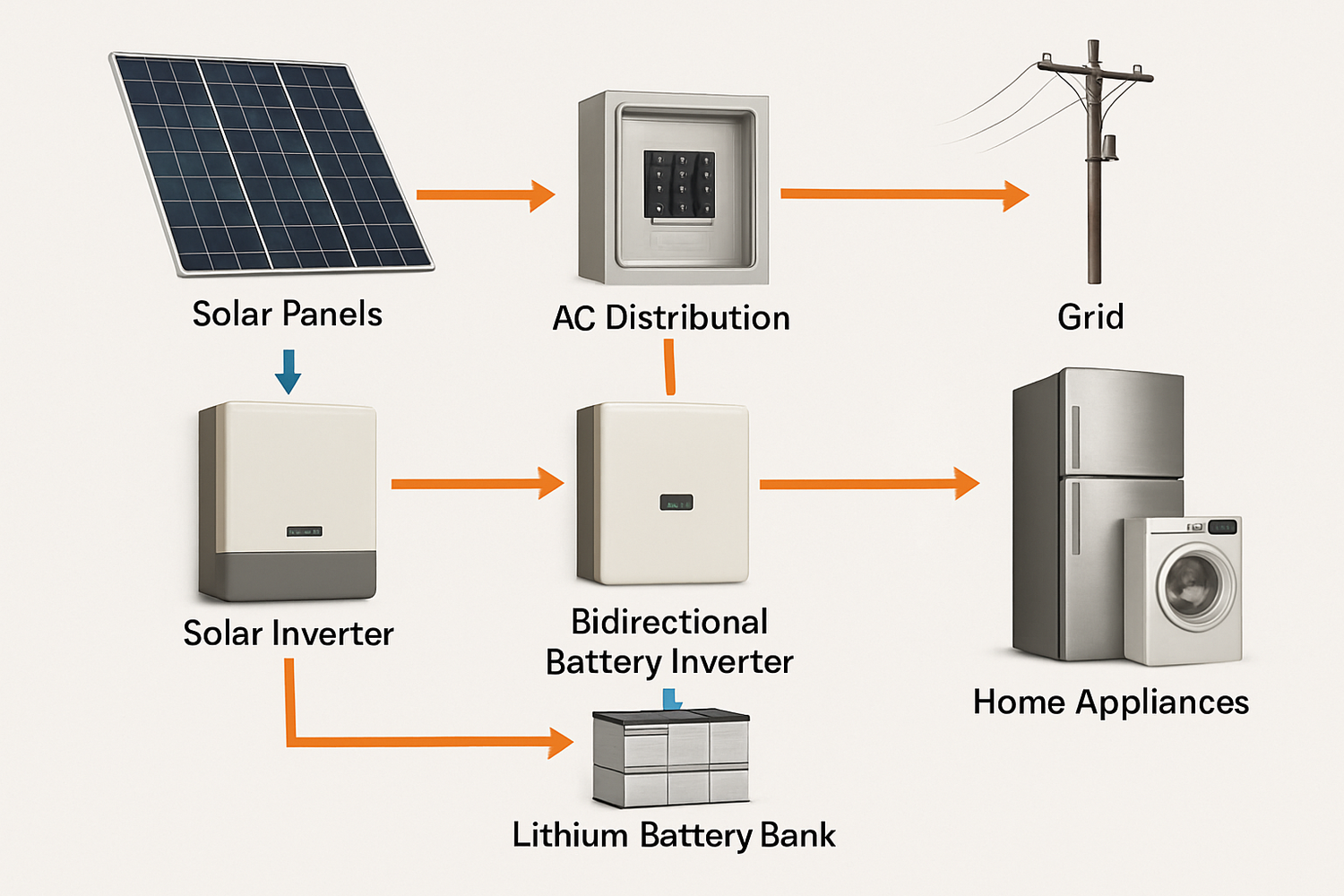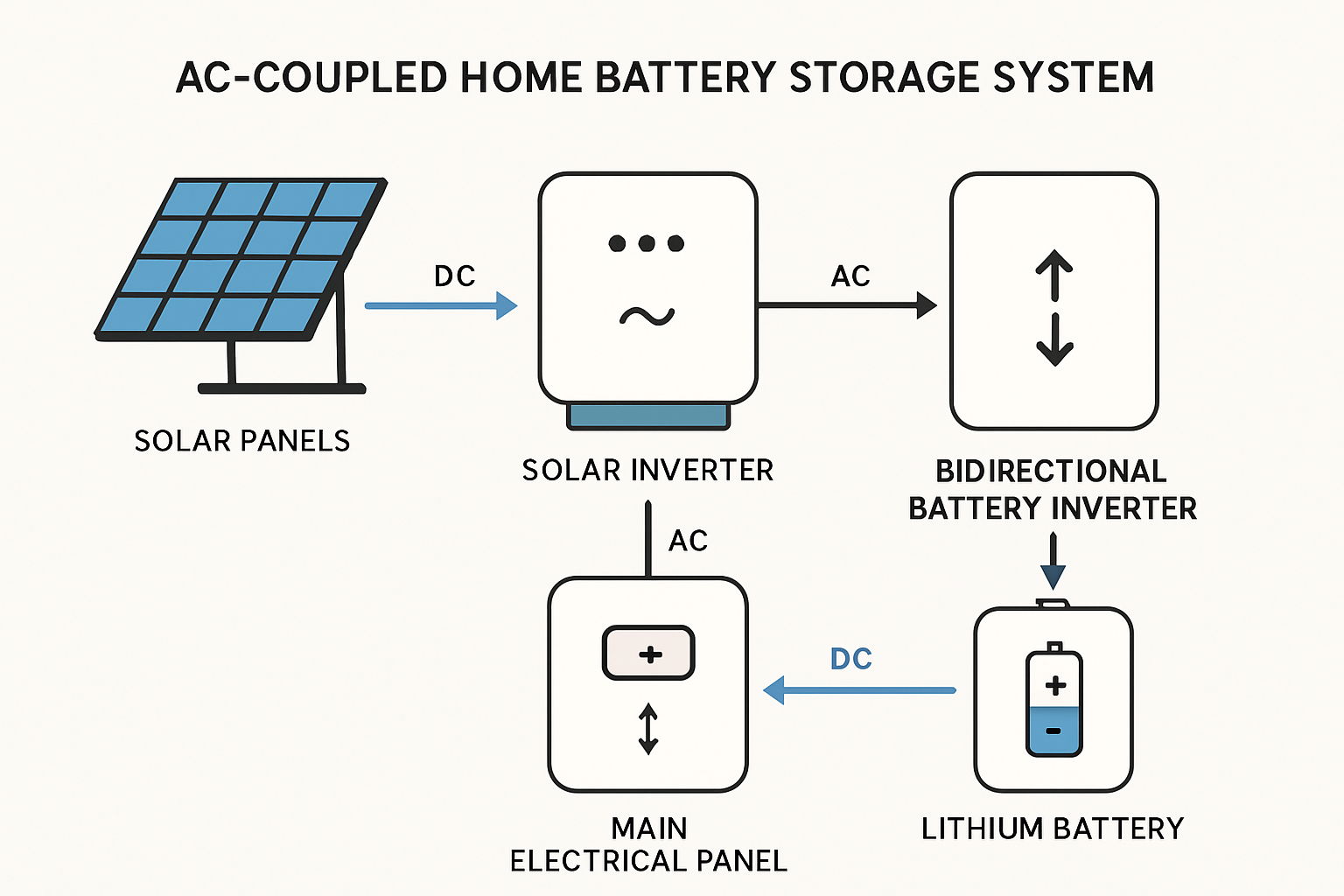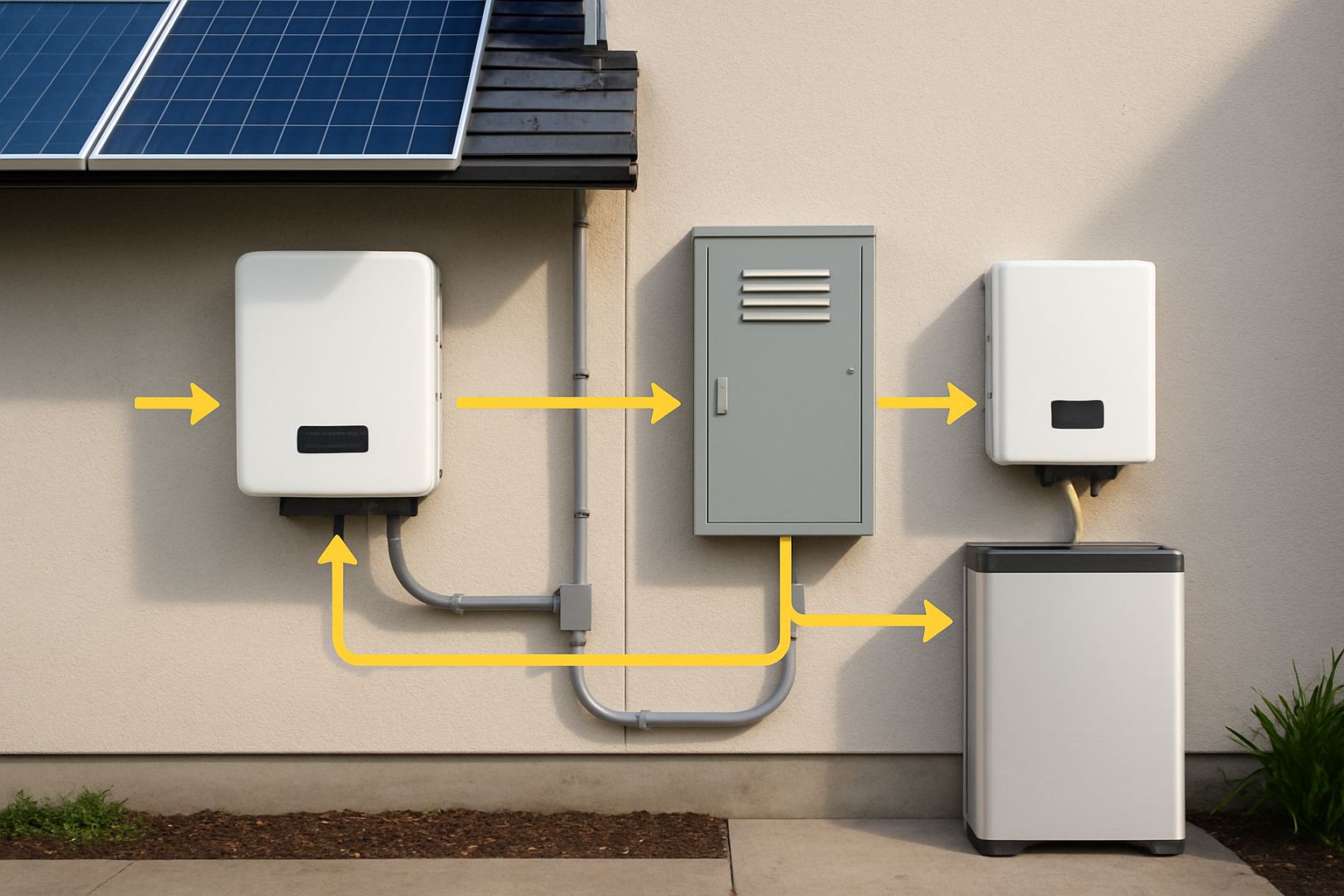As solar energy adoption grows, many homeowners are looking to add battery storage to gain energy independence and reliable backup power. A home battery storage system allows you to store excess solar energy for use at night or during grid outages. One of the most common methods for adding a battery to an existing solar installation is through AC coupling. This expert explainer clarifies what an AC coupled battery is, how it functions, and its primary applications.
The Foundation: AC and DC Power in a Solar System
To grasp the AC coupling explanation, it's helpful to first review the two types of electricity involved in a home solar setup. Understanding this distinction is key to seeing how different battery systems integrate with solar panels.
Direct Current (DC) from Solar Panels
Solar panels generate direct current (DC) electricity when sunlight strikes their photovoltaic cells. This is the raw form of energy produced by the array. While useful for charging batteries directly, it is not the type of power that runs most household appliances.
Alternating Current (AC) for Your Home
The standard form of electricity used in homes and businesses is alternating current (AC). Your refrigerator, lights, and television all run on AC power supplied by the utility grid. Therefore, the DC power from your solar panels must be converted to AC before it can be used.
The Inverter's Critical Role
The device responsible for this conversion is the solar inverter. It takes the DC electricity from the solar panels and transforms it into AC electricity that is compatible with your home's electrical system and the utility grid. The way a battery connects in relation to this inverter defines whether the system is AC or DC coupled.
How an AC Coupled Battery System Works
In an AC coupled battery system, the battery is connected to the alternating current (AC) side of the system. This means it is installed after the solar inverter has already converted the solar energy from DC to AC. This architecture involves its own dedicated inverter to manage the battery.
System Architecture and Energy Flow
An AC coupled setup has two distinct inverters: the original solar inverter and a second, bidirectional battery inverter. The energy flow involves a few conversion steps:
- Charging the Battery: Solar panels produce DC power, which is converted to AC by the solar inverter. If this AC power is not immediately used by the home, it flows to the battery inverter. The battery inverter then converts the AC power back to DC to charge the lithium battery.
- Discharging the Battery: When the home needs power (e.g., at night), the battery releases its stored DC energy. The battery inverter converts this DC power into AC power for the home's appliances to use.
This process is sometimes called a 'double conversion' because the energy is converted from DC to AC and then back to DC for storage.
Core Components of an AC Coupled System
A typical AC coupled battery system includes several key components working together:
- Solar Panels: The source of DC electricity.
- Grid-Tie Solar Inverter: Converts solar DC power to AC power.
- Battery Bank: Often a high-performance lithium iron phosphate battery (LiFePO4), such as a 12V 100Ah lithium battery, which is known for safety and longevity.
- Bidirectional Battery Inverter: A smart inverter that can convert AC to DC for charging and DC to AC for discharging.
- Battery Management System (BMS): An electronic system that protects the battery from overcharging, deep discharging, and other potential issues, ensuring safe and efficient operation.
Key Advantages of AC Coupling
AC coupled battery systems offer distinct benefits, making them a popular choice for specific scenarios, particularly for upgrading existing solar installations.
Ideal for Retrofitting Existing Solar Systems
The primary advantage of an AC coupled battery is the ease of adding it to an existing grid-tie solar system. Because it connects to the AC side, there is no need to modify the existing solar panel wiring or replace the original solar inverter. This makes for a simpler, faster, and often more cost-effective installation process for homeowners who already have solar panels.
System Modularity and Scalability
AC coupling allows the solar array and the battery system to operate independently. This modularity means you can size your battery storage without being limited by the specifications of your solar inverter. It also makes it easier to expand your battery capacity in the future by simply adding more batteries and compatible inverters.
Reliable Backup Power
During a grid outage, the battery inverter in an AC coupled system can create its own stable, independent AC grid for your home. This function, known as 'islanding,' allows your essential appliances to run on stored battery power. In many setups, the solar panels can continue to generate power to supply the home and recharge the battery even when the grid is down.
Potential Drawbacks and Considerations
While powerful and flexible, AC coupled systems have a couple of trade-offs to consider, primarily related to efficiency and cost.
Round-Trip Efficiency
The multiple conversions of power (DC to AC to DC for charging, and DC to AC for discharging) result in small energy losses at each step. This means the 'round-trip efficiency'—the amount of usable energy you get out of the battery compared to what you put in—is slightly lower than in DC coupled systems. While DC systems can reach efficiencies up to 98%, AC systems are typically in the 90-94% range. However, as noted in an ultimate reference on solar storage performance, using high-quality components minimizes these losses, making the difference negligible for many residential applications.
System Cost and Complexity
An AC coupled system requires two inverters—one for the solar panels and one for the battery. This can sometimes lead to a higher initial equipment cost compared to an integrated DC coupled system that uses a single hybrid inverter. However, for retrofits, this cost is often offset by lower labor and installation expenses.
A Final Word
An AC coupled battery system provides a highly flexible and effective way to add energy storage, especially to an existing solar installation. Its modular design and simple integration make it an accessible path toward greater energy independence and security. While there is a small trade-off in efficiency, the practical advantages of retrofitting and scalability make it the right solution for countless homeowners. The increasing global focus on renewable energy, as highlighted by the International Energy Agency (IEA), underscores the growing importance of effective storage solutions like AC coupled batteries to create a resilient and sustainable energy future.
Frequently Asked Questions
What is the main difference between an AC coupled and a DC coupled battery?
The primary difference is where the battery is connected to the system. An AC coupled battery connects to the AC wiring after the solar inverter, using its own inverter to charge and discharge. A DC coupled battery connects to the DC side, between the solar panels and a single hybrid inverter, allowing power to flow directly from the panels to the battery without conversion to AC.
Can I add an AC coupled battery to any existing solar system?
Generally, yes. AC coupled systems are designed to be compatible with virtually any existing grid-tie solar installation, regardless of the solar inverter brand. This universal compatibility is one of their most significant advantages for retrofitting.
How does an AC coupled system provide backup power during an outage?
During a grid failure, the battery's dedicated inverter disconnects from the grid and creates a local, stable AC power source for your home. This allows you to run essential loads using the energy stored in your battery. If the sun is shining, your solar panels can also continue to operate and recharge the battery simultaneously.
Is the efficiency loss in an AC coupled system a major concern?
For most residential applications, the slight efficiency loss (typically 4-8%) is not a major concern when weighed against the benefits of installation flexibility and scalability. High-quality inverters and batteries operate with very high efficiency, minimizing these conversion losses and ensuring you get the most out of your stored energy.





Leave a comment
All comments are moderated before being published.
This site is protected by hCaptcha and the hCaptcha Privacy Policy and Terms of Service apply.